warning SKODA ROOMSTER 2011 1.G Owner's Manual
[x] Cancel search | Manufacturer: SKODA, Model Year: 2011, Model line: ROOMSTER, Model: SKODA ROOMSTER 2011 1.GPages: 212, PDF Size: 3.3 MB
Page 164 of 212
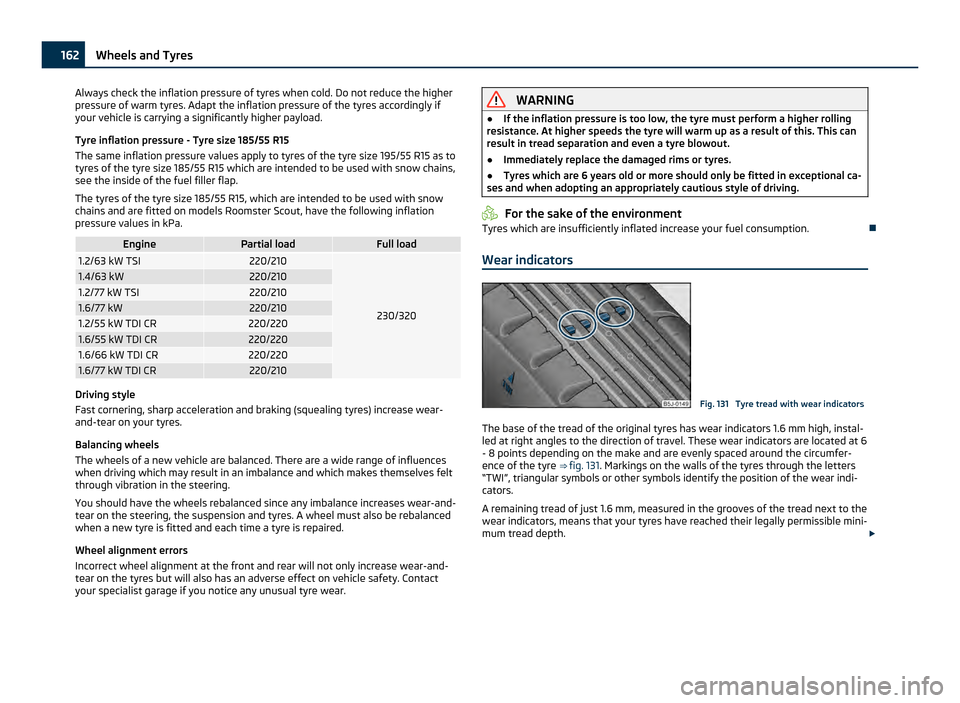
Always check the inflation pressure of tyres when cold. Do not reduce the higher
pressure of warm tyres. Adapt the inflation pressure of the tyres accordingly if
your vehicle is carrying a significantly higher payload.
Tyre inflation pressure - Tyre size 185/55
R15
The same inflation pressure values apply to tyres of the tyre size 195/55 R15 as to
tyres of the tyre size 185/55 R15 which are intended to be used with snow chains,
see the inside of the fuel filler flap.
The tyres of the tyre size 185/55 R15, which are intended to be used with snow
chains and are fitted on models Roomster Scout, have the following inflation
pressure values in kPa. Engine Partial load Full load
1.2/63 kW TSI 220/210
230/3201.4/63 kW 220/210
1.2/77 kW TSI 220/210
1.6/77 kW 220/210
1.2/55 kW TDI CR 220/220
1.6/55 kW TDI CR 220/220
1.6/66 kW TDI CR 220/220
1.6/77 kW TDI CR 220/210
Driving style
Fast cornering, sharp acceleration and braking (squealing tyres) increase wear-
and-tear on your tyres.
Balancing wheels
The wheels of a new vehicle are balanced. There are a wide range of influences
when driving which may result in an imbalance and which makes themselves felt
through vibration in the steering.
You should have the wheels rebalanced since any imbalance increases wear-and-
tear on the steering, the suspension and tyres. A wheel must also be rebalanced
when a new tyre is fitted and each time a tyre is repaired.
Wheel alignment errors
Incorrect wheel alignment at the front and rear will not only increase wear-and-
tear on the tyres but will also has an adverse effect on vehicle safety. Contact
your specialist garage if you notice any unusual tyre wear. WARNING
● If the inflation pressure is too low, the tyre must perform a higher rolling
resistance. At higher speeds the tyre will warm up as a result of this. This can
result in tread separation and even a tyre blowout.
● Immediately replace the damaged rims or tyres.
● Tyres which are 6 years old or more should only be fitted in exceptional ca-
ses and when adopting an appropriately cautious style of driving. For the sake of the environment
Tyres which are insufficiently inflated increase your fuel consumption.
Wear indicators Fig. 131 Tyre tread with wear indicators
The base of the tread of the original tyres has wear indicators 1.6 mm high, instal-
led at right angles to the direction of travel. These wear indicators are located at 6
- 8 points depending on the make and are evenly spaced around the circumfer-
ence of the tyre ⇒ fig. 131. Markings on the walls of the tyres through the letters
“TWI”, triangular symbols or other symbols identify the position of the wear indi-
cators.
A remaining tread of just 1.6 mm, measured in the grooves of the tread next to the
wear indicators, means that your tyres have reached their legally permissible mini-
mum tread depth. £162
Wheels and Tyres
Page 165 of 212

WARNING
● You must have your tyres replaced with new ones at the latest when the
wear indicators have been worn down. The legally permissible minimum tread
depth should be observed.
● Worn tyres do not provide the necessary adhesion to the road surface at
high speeds on wet roads. One could experience “ aquaplaning” (uncontrolled
movements of the vehicle - “swimming” on a wet road surface).
Changing wheels around If significantly greater wear is present on the front tyres, we recommend changing
the front wheels around with the rear wheels. You will then obtain approximately
the same life for all the tyres.
It may be advantageous to swap the tyres over
“crosswise” when uneven wear
characteristic arise on the running surfaces of the tyres (but not in the case of uni-
directional tyres). We recommend that you contact an authorised ŠKODA Service
Partner. They have extensive knowledge about the possible combinations.
We recommend that you change the wheels around every 10 000 km in order to
achieve even wear on all wheels and to obtain optimal tyre life.
New tyres and wheels Tyres and wheel rims are important design elements. One should therefore use
the tyres and wheel rims which have been released for use by
ŠKODA. They are
exactly matched to the vehicle type and therefore contribute significantly to good
road holding and safe driving characteristics ⇒ .
Only fit radial tyres of the same type on all 4 wheels, size (rolling circumference)
and, if possible, the same tread pattern on one axle.
Authorised
ŠKODA Service Partners have access to the most current information
about which tyres we have released for use on your vehicle.
We recommend that you have any work relating to tyres or wheels carried out by
an authorised ŠKODA Service Partner. Authorised ŠKODA Service Partners have all
of the necessary special tools and replacement parts available plus the required
specialist knowledge and are also in a position to properly dispose of the old tyres.
A large number of authorised ŠKODA Service Partners also have an attractive
range of tyres and wheels available. The tyre/wheel combinations which are approved for your vehicle are indicated in
your vehicle documents. Approval and licensing may differ according to the legis-
lation prevailing in individual countries.
Proper knowledge of the tyre data makes it easier for you to select the correct
type of tyre. Tyres do, for example, have the following inscription on their walls:
185/65 R 14 86 T
What this means is: 185 Tyre width in mm
65 Height/width ratio in %
R Code letter for the type of tyre -
Radial 14 Diameter of wheel in inches
86 Load index
T Speed symbol
The following speed restrictions apply to tyres.
Speed symbol Permissible maximum speed
Q 160 km/h
R 170 km/h
S 180 km/h
T 190 km/h
U 200 km/h
H 210 km/h
V 240 km/h
W 270 km/h
The date of manufacture
is also stated on the tyre wall (possibly only on the in-
side of wheel).
DOT ... 20 11...
means, for example, that the tyre was manufactured in the 20th week of the year
20011.
Any spare wheel which differs from the tyres fitted to the vehicle (e.g. winter
tyres or low-profile tyres) should only be used only for a short time in the event of
a puncture and when adopting an appropriately cautious style of driving. It should
be replaced as quickly as possible by a normal wheel. £ 163
Wheels and Tyres Using the system Safety Driving Tips General Maintenance Breakdown assis-
tance Praktik Technical data
Page 166 of 212
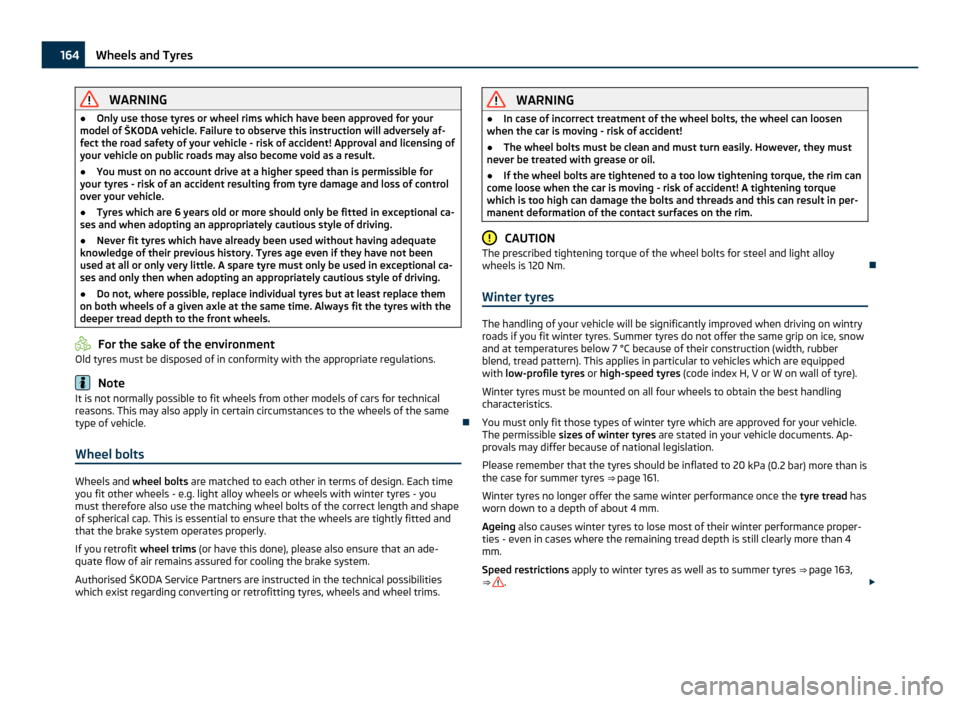
WARNING
● Only use those tyres or wheel rims which have been approved for your
model of ŠKODA vehicle. Failure to observe this instruction will adversely af-
fect the road safety of your vehicle - risk of accident! Approval and licensing of
your vehicle on public roads may also become void as a result.
● You must on no account drive at a higher speed than is permissible for
your tyres - risk of an accident resulting from tyre damage and loss of control
over your vehicle.
● Tyres which are 6 years old or more should only be fitted in exceptional ca-
ses and when adopting an appropriately cautious style of driving.
● Never fit tyres which have already been used without having adequate
knowledge of their previous history. Tyres age even if they have not been
used at all or only very little. A spare tyre must only be used in exceptional ca-
ses and only then when adopting an appropriately cautious style of driving.
● Do not, where possible, replace individual tyres but at least replace them
on both wheels of a given axle at the same time. Always fit the tyres with the
deeper tread depth to the front wheels. For the sake of the environment
Old tyres must be disposed of in conformity with the appropriate regulations. Note
It is not normally possible to fit wheels from other models of cars for technical
reasons. This may also apply in certain circumstances to the wheels of the same
type of vehicle.
Wheel bolts Wheels and
wheel bolts are matched to each other in terms of design. Each time
you fit other wheels - e.g. light alloy wheels or wheels with winter tyres - you
must therefore also use the matching wheel bolts of the correct length and shape
of spherical cap. This is essential to ensure that the wheels are tightly fitted and
that the brake system operates properly.
If you retrofit wheel trims (or have this done), please also ensure that an ade-
quate flow of air remains assured for cooling the brake system.
Authorised
ŠKODA Service Partners are instructed in the technical possibilities
which exist regarding converting or retrofitting tyres, wheels and wheel trims. WARNING
● In case of incorrect treatment of the wheel bolts, the wheel can loosen
when the car is moving - risk of accident!
● The wheel bolts must be clean and must turn easily. However, they must
never be treated with grease or oil.
● If the wheel bolts are tightened to a too low tightening torque, the rim can
come loose when the car is moving - risk of accident! A tightening torque
which is too high can damage the bolts and threads and this can result in per-
manent deformation of the contact surfaces on the rim. CAUTION
The prescribed tightening torque of the wheel bolts for steel and light alloy
wheels is 120 Nm.
Winter tyres The handling of your vehicle will be significantly improved when driving on wintry
roads if you fit winter tyres. Summer tyres do not offer the same grip on ice, snow
and at temperatures below 7 °C because of their construction (width, rubber
blend, tread pattern). This applies in particular to vehicles which are equipped
with low-profile tyres
or high-speed tyres (code index H, V or W on wall of tyre).
Winter tyres must be mounted on all four wheels to obtain the best handling
characteristics.
You must only fit those types of winter tyre which are approved for your vehicle.
The permissible sizes of winter tyres are stated in your vehicle documents. Ap-
provals may differ because of national legislation.
Please remember that the tyres should be inflated to 20
kPa (0.2 bar) more than is
the case for summer tyres ⇒ page 161.
Winter tyres no longer offer the same winter performance once the tyre tread has
worn down to a depth of about 4 mm.
Ageing also causes winter tyres to lose most of their winter performance proper-
ties - even in cases where the remaining tread depth is still clearly more than 4
mm.
Speed restrictions apply to winter tyres as well as to summer tyres ⇒ page 163,
⇒ .
£164
Wheels and Tyres
Page 167 of 212
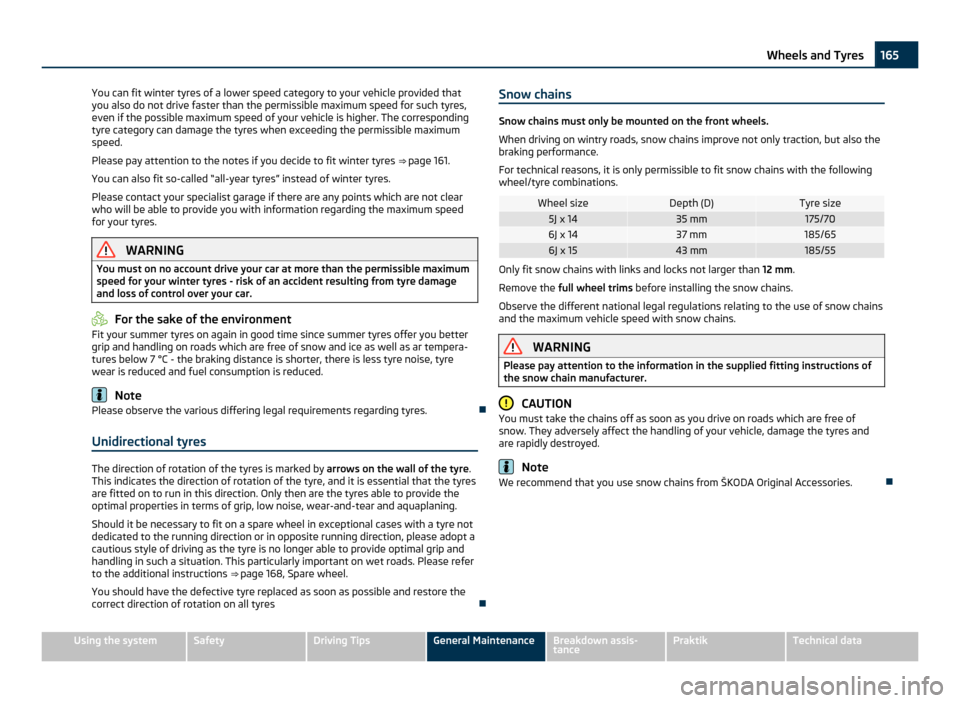
You can fit winter tyres of a lower speed category to your vehicle provided that
you also do not drive faster than the permissible maximum speed for such tyres,
even if the possible maximum speed of your vehicle is higher. The corresponding
tyre category can damage the tyres when exceeding the permissible maximum
speed.
Please pay attention to the notes if you decide to fit winter tyres
⇒
page 161.
You can also fit so-called “all-year tyres” instead of winter tyres.
Please contact your specialist garage if there are any points which are not clear
who will be able to provide you with information regarding the maximum speed
for your tyres. WARNING
You must on no account drive your car at more than the permissible maximum
speed for your winter tyres - risk of an accident resulting from tyre damage
and loss of control over your car. For the sake of the environment
Fit your summer tyres on again in good time since summer tyres offer you better
grip and handling on roads which are free of snow and ice as well as ar tempera-
tures below 7 °C - the braking distance is shorter, there is less tyre noise, tyre
wear is reduced and fuel consumption is reduced. Note
Please observe the various differing legal requirements regarding tyres.
Unidirectional tyres The direction of rotation of the tyres is marked by arrows on the wall of the tyre
.
This indicates the direction of rotation of the tyre, and it is essential that the tyres
are fitted on to run in this direction. Only then are the tyres able to provide the
optimal properties in terms of grip, low noise, wear-and-tear and aquaplaning.
Should it be necessary to fit on a spare wheel in exceptional cases with a tyre not
dedicated to the running direction or in opposite running direction, please adopt a
cautious style of driving as the tyre is no longer able to provide optimal grip and
handling in such a situation. This particularly important on wet roads. Please refer
to the additional instructions ⇒ page 168
, Spare wheel.
You should have the defective tyre replaced as soon as possible and restore the
correct direction of rotation on all tyres Snow chains Snow chains must only be mounted on the front wheels.
When driving on wintry roads, snow chains improve not only traction, but also the
braking performance.
For technical reasons, it is only permissible to fit snow chains with the following
wheel/tyre combinations. Wheel size Depth (D) Tyre size
5J x 14 35 mm 175/70
6J x 14 37 mm 185/65
6J x 15 43 mm 185/55
Only fit snow chains with links and locks not larger than
12 mm.
Remove the full wheel trims before installing the snow chains.
Observe the different national legal regulations relating to the use of snow chains
and the maximum vehicle speed with snow chains. WARNING
Please pay attention to the information in the supplied fitting instructions of
the snow chain manufacturer. CAUTION
You must take the chains off as soon as you drive on roads which are free of
snow. They adversely affect the handling of your vehicle, damage the tyres and
are rapidly destroyed. Note
We recommend that you use snow chains from ŠKODA Original Accessories. 165
Wheels and Tyres Using the system Safety Driving Tips General Maintenance Breakdown assis-
tance Praktik Technical data
Page 168 of 212

Accessories, changes and replacement of parts
General ŠKODA vehicles have been built according to the latest discoveries in safety engi-
neering. Thus one should not change the condition in which the vehicle was deliv-
ered from the manufacturer without some thought.
If you want to retrofit the vehicle with accessories, if a vehicle part is to be re-
placed with a new one, or when technical changes are to be made, the following
instructions must be observed:
● Advise should always be obtained from an authorised ŠKODA Service Partner
before buying any accessories or parts and before making any technical changes
⇒ .
● The guidelines and instructions issued by ŠKODA must be observed when
making technical changes.
Adhering to the prescribed procedures will prevent any kind of damage to the ve-
hicle, and its travelling and operating safety will be maintained. The vehicle also
complies with German road transport regulations (StVZO). More information is
available from an authorised
ŠKODA Service Partner who can also perform the
necessary work properly.
Interference on the electronic components and their software can lead to opera-
tional faults. This interference can also impair systems that are not directly affec-
ted because the electronic components are networked. In other words, the vehi-
cle's road-worthiness may be put at risk and increased wear on parts may arise.
Any damage caused by technical changes made without consent by ŠKODA is ex-
cluded from the warranty – see the warranty certificate. WARNING
● Work or modifications on your vehicle, which have been carried out unpro-
fessionally, can cause operational faults - risk of accident!
● We advise you, in your own interest, to only use ŠKODA Original Accesso-
ries and ŠKODA Original Parts which have been expressly approved for use on
your vehicle. Reliability, safety and suitability have been established for
ŠKODA Original Accessories and ŠKODA
Original Parts.
● Although we constantly monitor the market, we are not able to assess or
warrant the parts even though in some instances such parts may have a type
approval or may have been approved by a nationally recognised testing labo-
ratory. Note
● ŠKODA Original Accessories and
ŠKODA Original Parts can be bought from au-
thorised ŠKODA Service Partners who also professionally undertake the assembly
of parts which were purchased there.
● We recommend having all work undertaken by an authorised ŠKODA Service
Partner.
● All ŠKODA Original Accessories and Original Parts from the Original Accessories
catalogue, such as a towing device, child seats, etc. are authorised.
● We recommend that you also buy car stereos, aerials or other electrical acces-
sories from an authorised
ŠKODA Service Partner, who should also carry out the
installation. 166
Accessories, changes and replacement of parts
Page 169 of 212
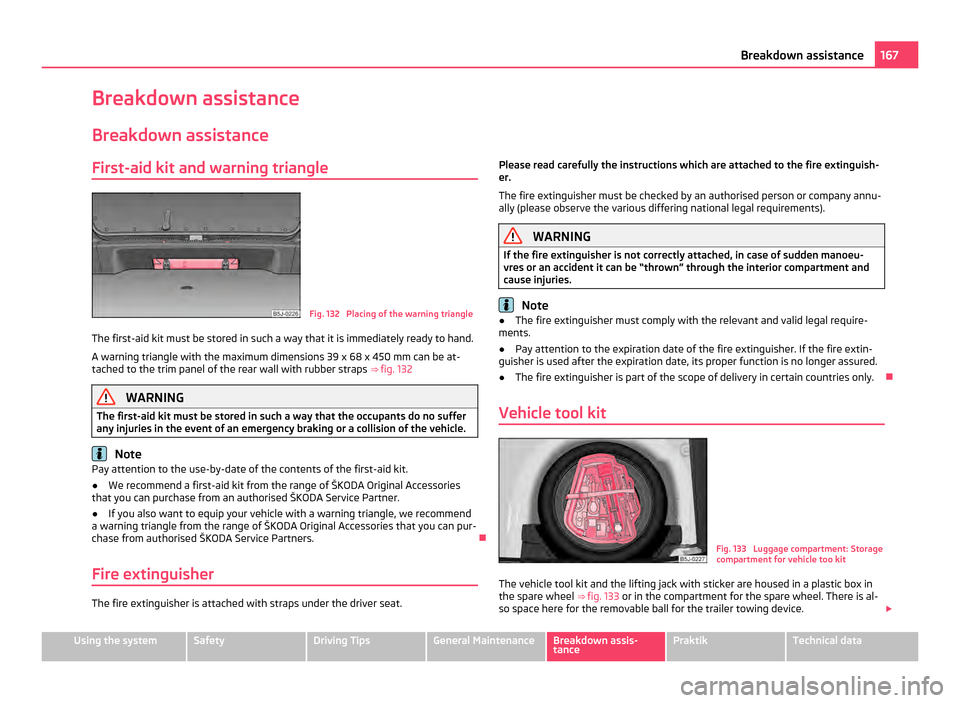
Breakdown assistance
Breakdown assistance
First-aid kit and warning triangle Fig. 132 Placing of the warning triangle
The first-aid kit must be stored in such a way that it is immediately ready to hand.
A warning triangle with the maximum dimensions 39 x 68 x 450 mm can be at-
tached to the trim panel of the rear wall with rubber straps ⇒ fig. 132 WARNING
The first-aid kit must be stored in such a way that the occupants do no suffer
any injuries in the event of an emergency braking or a collision of the vehicle. Note
Pay attention to the use-by-date of the contents of the first-aid kit.
● We recommend a first-aid kit from the range of ŠKODA Original Accessories
that you can purchase from an authorised
ŠKODA Service Partner.
● If you also want to equip your vehicle with a warning triangle, we recommend
a warning triangle from the range of
ŠKODA Original Accessories that you can pur-
chase from authorised ŠKODA Service Partners.
Fire extinguisher The fire extinguisher is attached with straps under the driver seat. Please read carefully the instructions which are attached to the fire extinguish-
er.
The fire extinguisher must be checked by an authorised person or company annu-
ally (please observe the various differing national legal requirements). WARNING
If the fire extinguisher is not correctly attached, in case of sudden manoeu-
vres or an accident it can be
“thrown” through the interior compartment and
cause injuries. Note
● The fire extinguisher must comply with the relevant and valid legal require-
ments.
● Pay attention to the expiration date of the fire extinguisher. If the fire extin-
guisher is used after the expiration date, its proper function is no longer assured.
● The fire extinguisher is part of the scope of delivery in certain countries only.
Vehicle tool kit Fig. 133 Luggage compartment: Storage
compartment for vehicle too kit
The vehicle tool kit and the lifting jack with sticker are housed in a plastic box in
the spare wheel ⇒ fig. 133 or in the compartment for the spare wheel. There is al-
so space here for the removable ball for the trailer towing device. £ 167
Breakdown assistance Using the system Safety Driving Tips General Maintenance Breakdown assis-
tance Praktik Technical data
Page 170 of 212
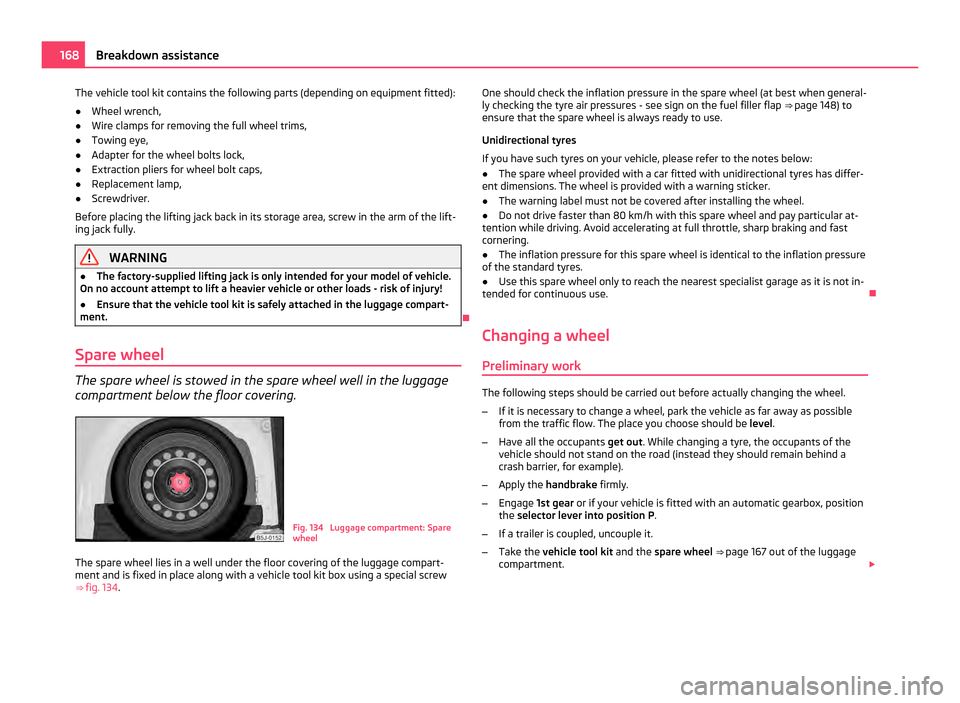
The vehicle tool kit contains the following parts (depending on equipment fitted):
●
Wheel wrench,
● Wire clamps for removing the full wheel trims,
● Towing eye,
● Adapter for the wheel bolts lock,
● Extraction pliers for wheel bolt caps,
● Replacement lamp,
● Screwdriver.
Before placing the lifting jack back in its storage area, screw in the arm of the lift-
ing jack fully. WARNING
● The factory-supplied lifting jack is only intended for your model of vehicle.
On no account attempt to lift a heavier vehicle or other loads - risk of injury!
● Ensure that the vehicle tool kit is safely attached in the luggage compart-
ment.
Spare wheel The spare wheel is stowed in the spare wheel well in the luggage
compartment below the floor covering.
Fig. 134 Luggage compartment: Spare
wheel
The spare wheel lies in a well under the floor covering of the luggage compart-
ment and is fixed in place along with a vehicle tool kit box using a special screw
⇒ fig. 134. One should check the inflation pressure in the spare wheel (at best when general-
ly checking the tyre air pressures - see sign on the fuel filler flap
⇒ page 148
) to
ensure that the spare wheel is always ready to use.
Unidirectional tyres
If you have such tyres on your vehicle, please refer to the notes below:
● The spare wheel provided with a car fitted with unidirectional tyres has differ-
ent dimensions. The wheel is provided with a warning sticker.
● The warning label must not be covered after installing the wheel.
● Do not drive faster than 80 km/h with this spare wheel and pay particular at-
tention while driving. Avoid accelerating at full throttle, sharp braking and fast
cornering.
● The inflation pressure for this spare wheel is identical to the inflation pressure
of the standard tyres.
● Use this spare wheel only to reach the nearest specialist garage as it is not in-
tended for continuous use.
Changing a wheel Preliminary work The following steps should be carried out before actually changing the wheel.
– If it is necessary to change a wheel, park the vehicle as far away as possible
from the traffic flow. The place you choose should be level.
– Have all the occupants get out. While changing a tyre, the occupants of the
vehicle should not stand on the road (instead they should remain behind a
crash barrier, for example).
– Apply the handbrake firmly.
– Engage 1st gear or if your vehicle is fitted with an automatic gearbox, position
the selector lever into position P .
– If a trailer is coupled, uncouple it.
– Take the vehicle tool kit and the spare wheel ⇒
page 167 out of the luggage
compartment. £168
Breakdown assistance
Page 171 of 212

WARNING
● If you find yourself in flowing traffic switch on the hazard warning lights
system and place the warning triangle on the side of the road at the prescri-
bed distance from your vehicle. Comply with the national legal regulations. In
this way you are protecting not only yourself but also other road users.
● Never start the engine with the vehicle sitting on the raised jack - danger
of suffering injury. CAUTION
If you have to change a wheel on a slope first block the opposite wheel with a
stone or similar object in order to secure the vehicle from unexpectedly rolling
away. Note
Comply with the national legal regulations.
Changing a wheel Always change a wheel on a level surface as far as possible.
–
Take off the full wheel trim ⇒ page 170 or the caps ⇒ page 170.
– Slacken the wheel bolts ⇒ page 170.
– Jack up the vehicle until the wheel to be changed is clear of the ground
⇒ page 171.
– Unscrew the wheel bolts and place them on a clean surface (cloth, paper, etc.).
– Take off the wheel.
– Fit on the spare wheel and tighten the wheel bolts slightly.
– Lower the car.
– Tighten the wheel bolts firmly, alternately and diagonally using the wrench
(crosswise) ⇒ page 170.
– Mount the full wheel trim/wheel trim cap or the caps. Note
● All bolts must be clean and must turn easily.
● You must never grease or oil the wheel bolts!
● When fitting on unidirectional tyres, ensure that the tyres rotate in the correct
direction ⇒ page 161
.
Subsequent steps After changing the wheel, you must perform the following steps.
–
Stow the vehicle tool kit in the space provided.
– Stow the replaced wheel in the luggage compartment.
– Check the tyre pressure on the spare wheel just mounted as soon as possible.
– Have the tightening torque of the wheel bolts checked with a torque wrench
as soon as possible. Steel and light alloy wheels must be tightened to a tight-
ening torque of 120
Nm.
– Change the damaged wheel or consult a specialist garage about possibilities
for getting repairs done. WARNING
It is necessary to observe the guidelines given on ⇒
page 163, New tyres and
wheels if the vehicle is subsequently fitted with tyres which are different to
those it was fitted with at the works. Note
● If you find, when changing the wheel, that the wheel bolts are corroded and
difficult to turn, the bolts must be replaced before checking the tightening torque.
● Drive cautiously and only at a moderate speed to a workshop where the tight-
ening torque can be checked. 169
Breakdown assistance Using the system Safety Driving Tips General Maintenance Breakdown assis-
tance Praktik Technical data
Page 173 of 212

Loosening the wheel bolts
–
Insert the wheel wrench fully onto the wheel bolt 1)
.
– Grasp the end of the wrench and turn the bolt about one turn to the left
⇒ fig. 137.
Tightening wheel bolts
– Insert the wheel wrench fully onto the wheel bolt 1 )
.
– Grasp the end of the wrench and turn the bolt to the right until it is tight. WARNING
Loosen the wheel bolts only a little (about one turn) while the vehicle has not
yet been jacked up - risk of an accident!. Note
● Apply pressure carefully with your foot to the end of the wrench if it is difficult
to loosen the bolts. Hold tight on the vehicle when doing this and ensure that you
have a steady position.
Raise vehicle You have to raise the vehicle with a lifting jack in order to be able
to take off the wheel.
Fig. 138 Changing a wheel: Jacking
points for positioning lifting jack Fig. 139 Attach lifting jack
Position the lifting jack by selecting the jacking point which is closest to the wheel
to be removed
⇒ fig. 138 . The jacking point is located directly below the engraving
in the lower sill.
– Position the lifting jack below the jacking point and move it up until its claw is
positioned directly below the vertical web of the lower sill.
– Align the lifting jack so that its claw grasps the web ⇒ fig. 139 at the right be-
low the embossing in the side surface of the base plate.
– Make sure that the base plate of the lifting jack rests with its entire surface on
level ground and is located vertical to the point ⇒
fig. 139 where the claw
grasps the web.
– Turn the lifting jack up further until the wheel is just clear of the ground. WARNING
● Always raise the vehicle with the doors closed - risk of injury.
● Never position any body parts such as arms or legs under the vehicle, while
the vehicle is raised with a lifting jack. £1)
Use the appropriate adapter for loosening and tightening the safety wheel bolts ⇒ page 172. 171
Breakdown assistance Using the system Safety Driving Tips General Maintenance Breakdown assis-
tance Praktik Technical data
Page 174 of 212
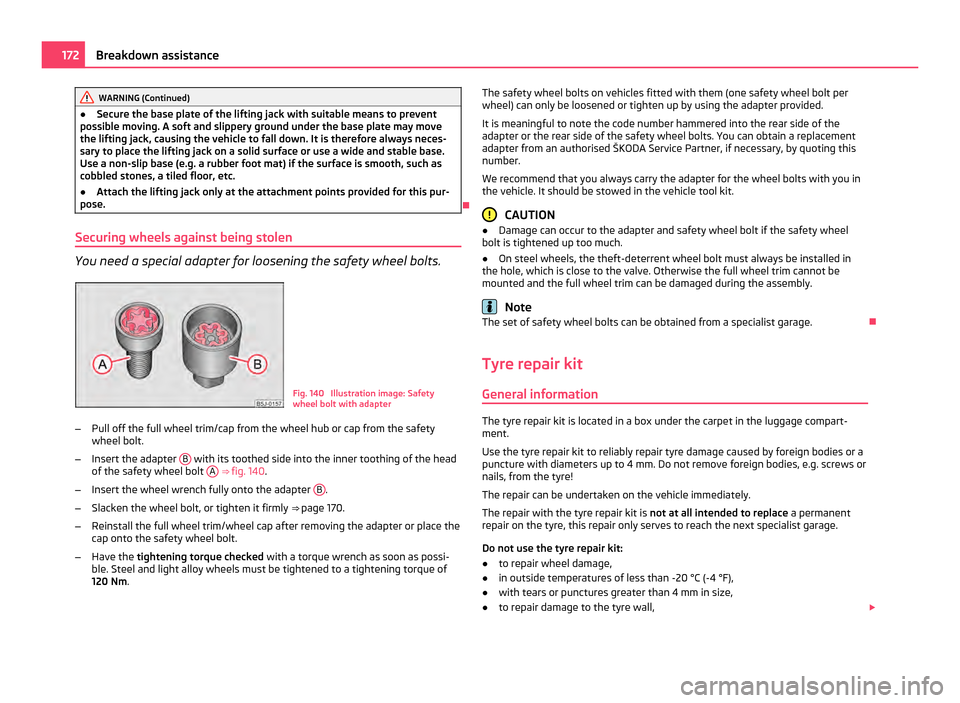
WARNING (Continued)
● Secure the base plate of the lifting jack with suitable means to prevent
possible moving. A soft and slippery ground under the base plate may move
the lifting jack, causing the vehicle to fall down. It is therefore always neces-
sary to place the lifting jack on a solid surface or use a wide and stable base.
Use a non-slip base (e.g. a rubber foot mat) if the
surface is smooth, such as
cobbled stones, a tiled floor, etc.
● Attach the lifting jack only at the attachment points provided for this pur-
pose.
Securing wheels against being stolen You need a special adapter for loosening the safety wheel bolts.
Fig. 140 Illustration image: Safety
wheel bolt with adapter
– Pull off the full wheel trim/cap from the wheel hub or cap from the safety
wheel bolt.
– Insert the adapter B with its toothed side into the inner toothing of the head
of the safety wheel bolt A
⇒
fig. 140 .
– Insert the wheel wrench fully onto the adapter B .
– Slacken the wheel bolt, or tighten it firmly ⇒ page 170.
– Reinstall the full wheel trim/wheel cap after removing the adapter or place the
cap onto the safety wheel bolt.
– Have the tightening torque checked with a torque wrench as soon as possi-
ble. Steel and light alloy wheels must be tightened to a tightening torque of
120
Nm. The safety wheel bolts on vehicles fitted with them (one safety wheel bolt per
wheel) can only be loosened or tighten up by using the adapter provided.
It is meaningful to note the code number hammered into the rear side of the
adapter or the rear side of the safety wheel bolts. You can obtain a replacement
adapter from an authorised
ŠKODA Service Partner, if necessary, by quoting this
number.
We recommend that you always carry the adapter for the wheel bolts with you in
the vehicle. It should be stowed in the vehicle tool kit. CAUTION
● Damage can occur to the adapter and safety wheel bolt if the safety wheel
bolt is tightened up too much.
● On steel wheels, the theft-deterrent wheel bolt must always be installed in
the hole, which is close to the valve. Otherwise the full wheel trim cannot be
mounted and the full wheel trim can be damaged during the assembly. Note
The set of safety wheel bolts can be obtained from a specialist garage.
Tyre repair kit General information The tyre repair kit is located in a box under the carpet in the luggage compart-
ment.
Use the tyre repair kit to reliably repair tyre damage caused by foreign bodies or a
puncture with diameters up to 4 mm. Do not remove foreign bodies, e.g. screws or
nails, from the tyre!
The repair can be undertaken on the vehicle immediately.
The repair with the tyre repair kit is not at all intended to replace a permanent
repair on the tyre, this repair only serves to reach the next specialist garage.
Do not use the tyre repair kit:
● to repair wheel damage,
● in outside temperatures of less than -20 °C (-4 °F),
● with tears or punctures greater than 4 mm in size,
● to repair damage to the tyre wall, £172
Breakdown assistance